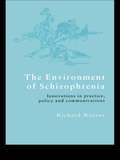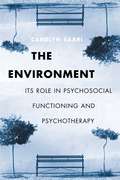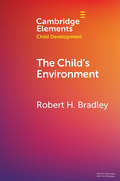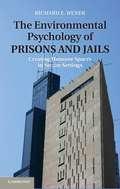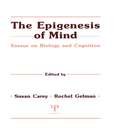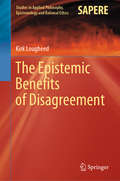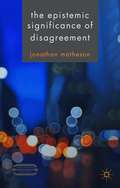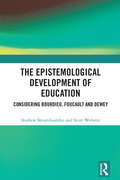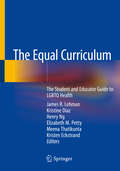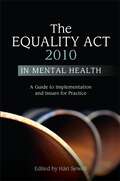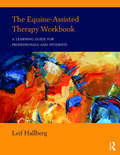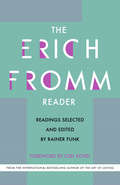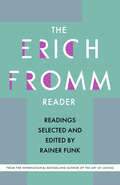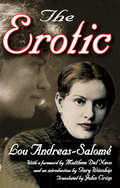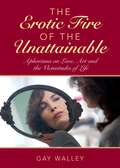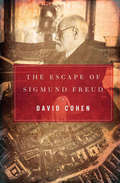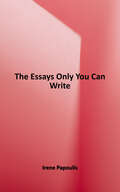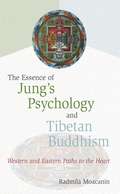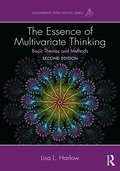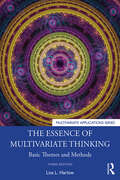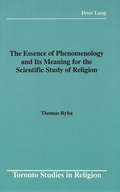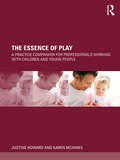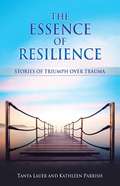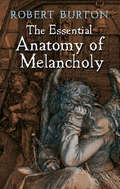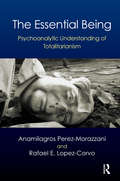- Table View
- List View
The Environment of Schizophrenia: Innovations in Practice, Policy and Communications
by Richard WarnerThere is now a body of evidence suggesting that the occurrence and course of schizophrenia are affected by a variety of environmental factors. The Environment of Schizophrenia draws upon our knowledge of these factors in order to design innovations that will decrease its incidence and severity, while enhancing the quality of life for sufferers and their relatives.Examining environmental forces operating at the individual, domestic and broad societal levels, Richard Warner proposes feasible interventions such as:* education about obstetric risks* marketing effective psychosocial treatments* business enterprises set up to employ people with mental illness* cognitive-behavioral therapy for psychosisThe Environment of Schizophrenis suggests practical ways to create a better world for those who suffer from this serious illness and for those who are close to them. It will prove fresh and stimulating reading for mental health managers and policy makers, as well as psychiatrists, clinical psychologists, mental health advocates, and communications specialists.
The Environment: Its Role in Psychosocial Functioning and Psychotherapy
by Carolyn SaariChallenging Freud's assumption that an individual first develops intrapsychically and is only later confronted with the demands of external reality, Carolyn Saari posits that human beings initially construct a picture of their immediate environment and then construct their identities within that environment. The Environment is an argument in three parts. Part 1 discusses psychoanalytic and developmental theory, showing that while such theory has assumed the existence of an environment, it has taken for granted and therefore left unexamined its role in human development. Michel Foucault's theory of social control provides the framework for Part 2, which examines psychotherapy's capacity either to liberate or to repress the client. Part 3 relates the practical benefits and broader implications of an inclusion of environmental considerations in the practice of psychotherapy.
The Environment: Where Children Spend Time and Become Who They Are (Elements in Child Development)
by Robert H. BradleyThe focus of this Element is on the environment and how it is implicated in children's development.A very broad array of social and physical features connected to children's home life and to the neighborhoods where children live, including multiple aspects of parenting, housing characteristics and the increased prevalence of media in daily life are addressed.Attention is also given to the broader social, economic, and geographic contexts in which children live, such as neighborhood surroundings and conditions in less developed countries.There is a focus on how various aspects of the home context (e.g., crowding) and key parental characteristics, such as mental illness and substance abuse problems, affect the behavior of parents. Consideration also given to how various forms of chaos and instability present challenges for parents and children and how those circumstances are implicated in both children's development and caregiver behavior.
The Environmental Psychology of Prisons and Jails
by Richard E. WenerThis book distils thirty years of research on the impacts of jail and prison environments. The research program began with evaluations of new jails that were created by the US Bureau of Prisons, which had a novel design intended to provide a non-traditional and safe environment for pre-trial inmates and documented the stunning success of these jails in reducing tension and violence. This book uses assessments of this new model as a basis for considering the nature of environment and behavior in correctional settings and more broadly in all human settings. It provides a critical review of research on jail environments and of specific issues critical to the way they are experienced and places them in historical and theoretical context. It presents a contextual model for the way environment influences the chance of violence.
The Epigenesis of Mind: Essays on Biology and Cognition (Jean Piaget Symposia Series)
by Susan Carey Rochel GelmanReflecting the focus of a Jean Piaget Symposium entitled Biology and Knowledge: Structural Constraints on Development, this volume presents many of the emergent themes discussed. Among these themes are: Structural constraints on cognitive development and learning come in many shapes and forms and involve appeal to more than one level of analysis. To postulate innate knowledge is not to deny that humans can acquire new concepts. It is unlikely that there is only one learning mechanism, even if one prefers to work with general as opposed to domain-specific mechanisms. The problems of induction with respect to concept acquisition are even harder than originally thought.
The Epistemic Benefits of Disagreement (Studies in Applied Philosophy, Epistemology and Rational Ethics #51)
by Kirk LougheedThis book presents an original discussion and analysis of epistemic peer disagreement. It reviews a wide range of cases from the literature, and extends the definition of epistemic peerhood with respect to the current one, to account for the actual variability found in real-world examples. The book offers a number of arguments supporting the variability in the nature and in the range of disagreements, and outlines the main benefits of disagreement among peers i.e. what the author calls the benefits to inquiry argument.
The Epistemic Significance of Disagreement
by Jonathan MathesonDiscovering someone disagrees with you is a common occurrence. The question of epistemic significance of disagreement concerns how discovering that another disagrees with you affects the rationality of your beliefs on that topic. This book examines the answers that have been proposed to this question, and presents and defends its own answer.
The Epistemological Development of Education: Considering Bourdieu, Foucault and Dewey
by Scott Webster Andrew SkourdoumbisThis book documents the political and economic ramifications of the policy impetus for a ‘science of education’ and what this means for classroom teachers, their teaching practices and for the field of education. In a critical exploration of current research and policy articulations of the purposes of education, with attention given to Australia, the UK and the USA, this book delineates the evaluative mechanisms involved in the strategic science as method adoption of accountability, competitiveness and test-driven criteria used in major education policy. It brings together the disciplines of sociology and philosophy by drawing on the theoretical insights of Michel Foucault, Pierre Bourdieu and John Dewey. In addition, the book argues for the deliberate use of the theoretical in education and is against the contemporary unquestioning advocacy that often accompanies a narrowly defined master narrative of a science of education. This book will be of special interest to post-graduate students as source material in general education courses and is also intended for academics with an interest in educational theory/philosophy and the sociology of education.
The Equal Curriculum: The Student and Educator Guide to LGBTQ Health
by Kristen Eckstrand James R. Lehman Kristine Diaz Henry Ng Elizabeth M. Petty Meena ThatikuntaThis first-of-its-kind textbook marks a revolutionary effort to reform medical education nationally by providing a comprehensive, high-quality resource to serve as a foundation for lesbian, gay, bisexual, transgender, and queer (LGBTQ) health education across multiple disciplines. Addressing the decades-long unequal weight of medical education generally offered about the care of LGBTQ people, The Equal Curriculum was created to advance clinicians' competencies in optimizing the health of LGBTQ people. This textbook is designed to be integrated into health sciences curricula and offers pointed strategies to evaluate the integration of LGBTQ health topics. Starting with a brief overview, chapters 1 through 4 cover general content that is highly relevant to all health professionals working with LGBTQ people. Chapters 5 through 12 focus on specific patient populations and clinical specialties, and chapters 13 and 14 cover special topics. Key points in each chapter are highlighted to aid in the comprehension, and case vignettes are provided throughout the textbook, allowing learners to apply the content to clinical scenarios in order to evaluate how the application of relevant knowledge may impact health outcomes. Questions similar to National Board of Medical Examiners (NBME) style are provided in most chapters to assist in the application of content. As major addition to the clinical literature, The Equal Curriculum: Student and Educator Guide to LGBTQ Health should be of great interest to health sciences instructors, medical students in their preclinical and clinical phases, and trainees from other disciplines, such as physician assistants, nurses, social workers, and public health professionals.
The Equality Act 2010 in Mental Health: A Guide to Implementation and Issues for Practice
by Scott Melba Wilson Sarah Carr Cheryl Brodie Barbara Vincent Sue Waterhouse Eleanor Hope Tony Jameson-Allen Marcel Vige Peter Gilbert Hári Sewell Jo Honigmann DurairajThe Equality Act 2010 in Mental Health provides a critical guide to the Act: what it means for mental health services and how it should be implemented. It addresses each of the nine characteristics protected by the Act in turn, examining the research and practice issue associated with each and offering positive guidance. Contributors also highlight the broader issues associated with achieving equality in mental health, including conflicts between different forms of discrimination, the impact of budget cuts and the issue of inequality in wider society and how it relates to the mental health services. Finally, the book tackles organisational change and the implications for management practice, organisational structures and staff training. This book will be a valuable resource for those involved in providing mental health services, including managers and frontline workers across health and social care.
The Equine-Assisted Therapy Workbook: A Learning Guide for Professionals and Students
by Leif HallbergThe Equine-Assisted Therapy Workbook gives readers the tools they need to increase professional competency and personalize the practical applications of equine-assisted therapy. Each chapter includes thought-provoking ethical questions, hands-on learning activities, self-assessments, practical scenarios, and journal assignments applicable to a diverse group of healthcare professionals. The perfect companion to The Clinical Practice of Equine-Assisted Therapy, this workbook is appropriate for both students and professionals.
The Erich Fromm Reader
by Erich Fromm Rainer Funk Joel KovelFromm's basic idea was to look at the individual as a social being and to look at society as an ensemble of many individuals who have not only common ideas and convictions based on a common practice of life but also a common psychic structure. With his concept of "social character" he created a new interdisciplinary thinking presented in this reader. The Erich Fromm Reader exhibits the true genius of an original thinker in seeing the connections between overlapping knowledge from many different fields. Here interdisciplinarity is not only a lip service but the impact of Erich Fromm's unique social psychological notion.
The Erich Fromm Reader: Readings Selected and Edited by Rainer Funk
by Erich Fromm&“Fromm crossed the boundaries of traditional disciplines to expound his view on the alienation of man in an increasingly technological world.&” —Newsweek Erich Fromm&’s basic idea was to look at the individual as a social being, and to look at society as an ensemble of many individuals who have not only mutual ideas and convictions based on a common practice of life, but also a shared psychic structure. With his concept of &“social character,&” Fromm created a new interdisciplinary thinking presented in this compendium.The Erich Fromm Reader exhibits the true genius of an original thinker in seeing the connections between overlapping knowledge from many different fields. Here, interdisciplinarity is not only a lip service but the impact of Erich Fromm&’s unique social psychological notion.
The Erotic
by Lou Andreas-SalomePsychoanalyst and author Lou Andreas-Salome may seem to be a figure remote from us, one belonging to a pre-1914 Europe, but in many ways, she is our contemporary. She travelled in a highly romantic world as socialite, sociologist, and author. She was part of Georg Simmel's salon, the most exclusive in Berlin, frequented by elusive poet Stefan Georg, dramatist Paul Ernst, social theorist and polymath Max Weber, and Georg Lukacs, among others.Salome's unique contribution to the erotic was that she argued sexual difference ran deeper than economics and equality—the politics of Marx and the ideals of the French Revolution. For Salome, to think about women and their erotic nature, you must start with their biological and psychological difference, not their economic situation.Salome was an outstanding theorist. Her books on Nietzsche and on Rilke are major studies. The field of psychoanalysis would not have developed in the way it did without Lou Andreas-Salome. We cannot understand Freud's "rationalism" or his anti-religious sensibility without Salome's writings. This new English translation is an essential text of psychoanalysis, one that shaped the very conception of the field.
The Erotic Fire of the Unattainable: Aphorisms on Love, Art, and the Vicissitudes of Life
by Gay WalleyThe Erotic Fire of the Unattainable has a subtle narrative wherein author Gay Walley weaves love with life, art with making a living, and inspiration with the banal realities of daily life. The book shows how passion is to be found in every moment, none the least in a passion for independence. Beginning with "Why Women Fight Pirates," Walley covers such disparate topics as "The Disappointments of Infidelity," "Talk in Love," "Writers," "Work and its Punishments," "The Importance of the Argument," "The Ocean," "New York," and ends on "Deathbed."This unflinching narrative is a journey through an artist's mind, taking us outside the usual confines, to lovers and ex-husbands, traveling, solitude, money and the importance of rebellion.
The Escape of Sigmund Freud
by David CohenThe &“gripping&” true story of the founder of psychoanalysis—and how he made it out of Austria after the Nazi takeover (The Independent). Sigmund Freud was not a practicing Jew, but that made no difference to the Nazis as they burned his books in the early 1930s. Goebbels and Himmler wanted all psychoanalysts, especially Freud, dead, and after the annexation of Austria, it became clear that Freud needed to leave Vienna. But a Nazi raid on his house put the Freuds&’ escape at risk. With never-before-seen material, this biography reveals details of the last two years of Freud&’s life, and the people who helped him in his hour of need—among them Anton Sauerwald, who defied his Nazi superiors to make the doctor&’s departure possible. The Escape of Sigmund Freud also delves into the great thinker&’s work, and recounts the arrest of Freud&’s daughter, Anna, by the Gestapo; the dramatic saga behind the signing of Freud&’s exit visa and his eventual escape to London; and how the Freud family would have an opportunity to save Sauerwald&’s life in turn. &“Full of fascinating insights and anecdotes . . . Cohen draws copiously on the correspondence between Freud and [his nephew] Sam to paint a vivid picture of their complex and deeply troubled family.&” —Daily Mail &“An illuminating look at the end of the life of a giant of psychology.&” —Kirkus Reviews
The Essays Only You Can Write
by Irene PapoulisThis book offers a perspective on essay writing that spotlights a writer’s uniqueness. Resisting the perception that personal and academic writing is at odds with one another, it treats the impulse to write “personally” as potential fuel for a variety of writing purposes. The book encourages students to think like academics--pursuing their enthusiasms, trusting their ideas, and questioning their conclusions--by leading them through three main writing assignments: a personal essay, an essay based on texts, and a research essay. Each chapter offers exercises and strategies for various stages in the pre-writing, drafting, and revision processes. Freewriting; extensive attention to planning; devising a structure and order of ideas that both promote and reflect engagement with a topic; developing rhetorical awareness and knowledge of conventions; and an advocacy for expressive, socially-responsible writing--all are central elements of the text’s instruction. By acknowledging the emotions inherent in the writing process, many of which can muddle thinking--I don’t want anyone to see this; what if I make mistakes? what if the writing isn’t good? I don’t want to be critiqued; etc.--Papoulis helps beginning college writers to navigate the psychological as well as the technical roadblocks that can get in the way of their best personal and academic writing.
The Essence of Jung's Psychology and Tibetan Buddhism
by Radmila MoacaninThe Essence of Jung's Psychology and Tibetan Buddhism cuts to the heart of two very different yet remarkably similar traditions. The author touches on many of their major ideas: the collective unconscious and karma, archetypes and deities, the analyst and the spiritual friend, and mandalas. Within Tibetan Buddhism she focuses on tantra and relates its emphasis on spiritual transformation, also a major concern of Jung. This expanded edition includes new material on the integration of the two traditions, and the importance of these paths of the heart in today's unsteady world.
The Essence of Multivariate Thinking: Basic Themes and Methods (Multivariate Applications Series)
by Lisa L. HarlowBy focusing on underlying themes, this book helps readers better understand the connections between multivariate methods. For each method the author highlights: the similarities and differences between the methods, when they are used and the questions they address, the key assumptions and equations, and how to interpret the results. The concepts take center stage while formulas are kept to a minimum. Examples using the same data set give readers continuity so they can more easily apply the concepts. Each method is also accompanied by a worked out example, SPSS and SAS input, and an example of how to write up the results. EQS code is used for the book’s SEM applications. ?This extensively revised edition features: New SEM chapters including an introduction (ch.10), path analysis (ch.11), confirmatory factor analysis (ch.12), and latent variable modeling (ch.13) the last three with an EQS application. A new chapter on multilevel modeling (ch. 8) that is now used more frequently in the social sciences. More emphasis on significance tests, effect sizes, and confidence intervals to encourage readers to adopt a thorough approach to assessing the magnitude of their findings. A new data set that explores the work environment. More discussion about the basic assumptions and equations for each method for a more accessible approach. New examples that help clarify the distinctions between methods. A new website at https://sites.google.com/site/multivariatesecondedition/ that features the datasets for all of the examples in the book for use in both SPSS and SAS and in EQS for the SEM chapters. The first two chapters review the core themes that run through most multivariate methods. The author shows how understanding multivariate methods is much more achievable when we notice the themes that underlie these statistical techniques. This multiple level approach also provides greater reliability and validity in our research. After providing insight into the core themes, the author illustrates them as they apply to the most popular multivariate methods used in the social, and behavioral sciences. First, two intermediate methods are explored – multiple regression and analysis of covariance. Next the multivariate grouping variable methods of multivariate analysis of variance, discriminant function analysis, and logistic regression are explored. Next the themes are applied to multivariate modeling methods including multilevel modeling, path analysis, confirmatory factor analysis, and latent variable models that include exploratory structural methods of principal component and factor analysis. The book concludes with a summary of the common themes and how they pertain to each method discussed in this book. ?Intended for advanced undergraduate and/or graduate courses in multivariate statistics taught in psychology, education, human development, business, nursing, and other social and life sciences, researchers also appreciate this book‘s applied approach. Knowledge of basic statistics, research methods, basic algebra, and finite mathematics is recommended.
The Essence of Multivariate Thinking: Basic Themes and Methods (Multivariate Applications Series)
by Lisa L. HarlowFocusing on the underlying themes that run through most multivariate methods, in this fully updated 3rd edition of The Essence of Multivariate Thinking Dr. Harlow shares the similarities and differences among multiple multivariate methods to help ease the understanding of the basic concepts. The book continues to highlight the main themes that run through just about every quantitative method, describing the statistical features in clear language. Analyzed examples are presented in 12 of the 15 chapters, showing when and how to use relevant multivariate methods, and how to interpret the findings both from an overarching macro- and more specific micro-level approach that includes focus on statistical tests, effect sizes and confidence intervals. This revised 3rd edition offers thoroughly revised and updated chapters to bring them in line with current information in the field, the addition of R code for all examples, continued SAS and SPSS code for seven chapters, two new chapters on structural equation modeling (SEM) on multiple sample analysis (MSA) and latent growth modeling (LGM), and applications with a large longitudinal dataset in the examples of all methods chapters. Of interest to those seeking clarity on multivariate methods often covered in a statistics course for first-year graduate students or advanced undergraduates, this book will be key reading and provide greater conceptual understanding and clear input on how to apply basic and SEM multivariate statistics taught in psychology, education, human development, business, nursing, and other social and life sciences.
The Essence of Phenomenology and Its Meaning for the Scientific Study of Religion
by Thomas RybaReligious studies is rife with confusion over what the phenomenology of religion is. Conventional approaches dwell on the dissimilarity of the meanings of 'phenomenology' and 'phenomenology of religion' and ignore their synonymy. The purpose of this book is to challenge this trend by examining seven significant historical examples of philosophical phenomenology in order to develop a synthetic definition of 'phenomenology' which will both resolve the perceived conflicts in meaning and lead to a useful augmentation of religious methodology.
The Essence of Play: A Practice Companion for Professionals Working with Children and Young People
by Justine Howard Karen McInnesA unique companion to professional play practice! All play professionals are united in their belief that play is important for children’s development – and there are inherent characteristics of play that underpin professional play practice across contexts. Providing an overarching concept of play, drawing together the evidence base across disciplines and linking theory to practice, The Essence of Play is the ideal handbook for all those working with children. Play acts as a natural resource for children to meet physical, intellectual and emotional challenges and this book, unusually, considers play from the perspectives of children rather than adults. It provides a baseline of shared knowledge for all play professionals, exploring the fundamental value of play rather than a ‘how to’ approach to practice. It considers: the therapeutic potential inherent in play; how play reflects and promotes physical, emotional, intellectual, linguistic and social abilities; the emergence of different types of play skills and why these are important; cross-cultural patterns in play, gender, atypicality and adversity, highlighting the relevance of these issues to professional play practice; the benefits of utilising play for assessment and other professional practice issues such as ethical play practice, balancing risk with health and safety and the creation and management of boundaries. This text is designed for students and practitioners working with children across the helping professions, including early years education, play therapy, playwork, childcare, social care, nursing and allied health. Each chapter provides directed reading and small reflective tasks to encourage readers to digest key issues.
The Essence of Resilience: Stories of Triumph over Trauma
by Kathleen Parrish Tanya LauerWhen trauma enters the lives of the unsuspecting, it steals from their very soul. It not only robs them of peace and joy, it can take years and decades from their lives while they desperately try to fill the hole in their heart, pretending that their soul isn't leaking out of it. No one is ever prepared for trauma and no one is ever left unchanged by traumatic events. In the face of such adversity, what allows one person to find the gift in their wound and another to suffer endlessly? Enter Tanya Lauer and Kathleen Parrish, professional counselors at the internationally renowned residential treatment center, Cottonwood Tucson. With over 40 years combined experience helping people survive trauma and find the "gift in their wound," Lauer and Parrish offer The Essence of Resilience—an urgent and vital answer to this all-too-common marauder. Topical tools for healing include: Story, Relationships, Trust, Compassion, Gratitude, Animals and Pets, Nature, Humor, and Spirituality. Through stories, compassion and understanding, they guide readers straight to the heart of resilience—that place where we learn to heal and thrive.
The Essential Anatomy of Melancholy
by Robert BurtonEnglish churchman and scholar Robert Burton (1577-1640) was a passionate student of medicine, history, literature, and science — the whole of human knowledge. This witty and eloquent genius devoted most of this life to writing The Anatomy of Melancholy, one of the richest, most inexhaustible books in the English language.Ostensibly an elaborately systematized medical treatise dealing with various morbid mental states — their causes, symptoms, and cures — the Anatomy is much more: a compendium of memorable utterances on the human condition in general, compiled from classical, scholastic, and contemporary sources. For this edition, the editors carefully selected passages of the most psychological and general interest, eliminating the nonessential material but retaining the incomparable humor, eccentric charm, imagination, and thought-provoking appeal of the original.In short, readers will find here the essence of Burton's vast book — the passages that, according to noted scholar W. H. D. Rouse, reveal the author's "eternal freshness, his own ingenuous interest, [and] his boyish delight in a good story."
The Essential Being: Psychoanalytic Understanding of Totalitarianism
by Anamilagros Perez MorazzaniThis book explores the concept of "pre-conceptual trauma", drawing in particular on the pioneering research of Wilfred Bion. A comparison is established between two different groups of individuals: five well-known dictators and five famous creative individuals. The authors have defined "pre-conceptual traumas" as ubiquitous experiences that all human beings go through during the first years of their lives, when a temporary absence changes into a permanent presence, determining the outcome of what any individual might do or perform in the future. Pre-conceptual traumas split the mind into two dialectical and correlated states: the "traumatized" (conflictive or pathological), and the "non-traumatized (developmental or normal).
